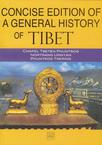西藏简明通史
2011-6
恰白•次旦平措、等、 许华锋 五洲传播出版社 (2011-06出版)
恰白·次旦平措
许华锋
《西藏简明通史(英文版)》depicts a panorama of the history of Tibet based on its regime evolution, which clearly reveals the process and special laws of Tibet becoming an integrated part of China, indicating the ethnic diversity and unity of the Chinese nation.
Chapter One Prehistory Period Section One The origin of the name "bod-ljong" Section Two The formation of Tibetan plateau Section Three The origin of Tibetan people Chapter Two The Royal Lineage of Pugyal Chapter Three The Royal Lineage of Tubo Tsenpo Section One Tsenpo Songtsen Gampo Section Two Gungsong Gungsten and Mangsong Mangtsen Section Three Tsenpo Dusong Mangpoje Section Four Tsenpo Tride Tsugtsen Section Five Trisong Detsen Section Six Prince Muni Tsenpo Section Seven Tride Songtsen Sadnaleg Section Eight Tsenpo Tritsug Detsen Ralpachen Section Nine Tsenpo Lang DarmaWudum Tsen Chapter Four The Division Period in Tibet Section One The Story about Ardaweisong, Yumtan and their descendants Section Two The history of the later period of the spread of Buddhism in Tibet Section Three The sects in the division period of Tibet Chapter Five The Reign of Sakyapa Clan in Tibet Section One The Situation of Tibet and the Royal Lineage of Sakyapa Clan in the Early of the 13th Century Section Two The influence of descendants of Genghis Khan in Tibet and the reunification of Tibet Section Three Mongolian prince Ngorchen Godan invited Sakya Pandita to inland China Section Four Letter from Sakya Pandita addressed to every regional leader in Tibet Section Five The meeting between Phagpa and Kublai Khan; Edit on awarding and protecting Buddhist monks Section Six Sechen Khan invited Karma Pakshi to inland China Section Seven Declaration of putting three Chokha of Tubo under the rule ofYuan; Establishment ofpost houses in Tibet Section Eight Issuance of Pearl Edict; Phagpa returned to Tibet to build new organization of Sakya Section Nine Phagpa as the political consultant to the Emperor of Yuan Section Ten Phagpa returned to Tibet again and died; Yuan stationed troops in Tibet Section Eleven Chakna Dorje and his son Section Twelve The contradiction between Sakya and Drigung was escalated; The Chaos of Drigung Monastery Section Thirteen The story of Sakya Danyi Chenpo Sangpopal Section Fourteen Yuan conducted three censuses and established administrative system in Tibet Section Fifteen Yuan Dynasty gave official title to Sakya ruling group Section Sixteen Some examples of the Sakyapa's administration of the affairs in Tibet at the edit of the emperors of Yuan Section Seventeen The economic development in Tibet in the time of rule by Sakyapa Section Eighteen The cultural development of Tibet in the reign of Sakyapa Section Nineteen Shongton Lotsawa Dorje Gyaltsen ushered in a new era of Tibetan literature Section Twenty The Sakya Family was split into four Ladrangs and the rule of Sakyapaended. Chapter Six The Phagmo Drupa Time of Tibet Section One The Lang Family with Phagdru Kagyu, Phagdru Trikor and Phagdru Desi Section Two Ming Dynasty's administration over Tibetan local regime Section Three Tibet's Economic and Cultural Development in the Period of Phagdru Regime Section Four Gelug during Phagdru Regime Section Five History of Depa Rinpungpa ection Six History of Desi Tsangpa Chapter Seven The Ganden Phodrang Regime Section One The history surrounding the Fifth Dalai Lama-Ngawang Losang Gyatso Section Two The story of the Sixth Dalai Lama Tsangyang Gyatso Section Three The period of the seventh Dalai Lama Kelsang Gyatso Section Four The period of the 8th Dalai Lama-lempel Gyatso Section Five The 9th Dalai Lama-Lungtok Gyatso Section Six The period of the 10th Dalai Lama-Tsultrim Gyatso Section Seven The period of the 11th Dalai Lama Khedrup Gyatso Section Eight The period of the 12th Dalai Lama Trinley Gyatso Section Nine The period of the 13th Dalai Lama-Thubten Gyatso Section Ten Some of the Prominent figures in the Ganden Phodrang period
版权页: The Death Price and the medical expense compensation were supposed to be paid in gold and silver. However, in reality silver could be used to take the place of gold. 2) Not stealing code It's a criminal law about punishing thieves. If a thief stole treasures in a temple or from Buddha statues, pagodas, Buddhist scriptures, the criminal should pay an indemnity one hundred times as much as the value of the stolen object. If the property of the king or ministers were stolen, the thief should pay an indemnity eighty times as much as the value of the stolen object. If the property of the common people were stolen, the thief should pay an indemnity eight times as much as the value of the stolen object. The principal criminal who rioted and stole would be given capital punishment or exiled. 3) Not indulging in sexual misconduct code Assault was regarded as felony. The limbs of a fornicator would be cut off. He or she would be reduced to serf and sent into exile in frontier regions. Those who raped princess or other noble women would be punished by cutting off their limbs. Those who raped other man's wife would be punished with hanging. 4) Not lying code When a crime or litigation happened, the prosecutor and defender must explain in court the details about what had happened. If the offender refused to admit his mistake or tried to get away with it. He must swear to his dharmapala as witness. This was called "cleansing the heart of sin by way of argument"(Nyonham Nadaggi Shalci). 5) No drinking alcohol code If somebody drank too much alcohol and caused serve harm, he must be punished according to law. 6) Serfs not rebelling against their masters code was a law that forbade serfs from rebelling. The common people and serfs must obey the rule of their masters and pay taxes. In addition, they should not betray and rebel against their masters. 7) Not grave robbing code was a law that forbade people fromstealing property from graves.
《西藏简明通史(英文版)》由五洲传播出版社出版。
